PORT TOWNSEND –– An amateur historian who helped exhume an anchor he believes is from Capt. George Vancouver’s 18th-century exploration of the Pacific Northwest will explain tonight why he thinks his anchor is the one historians have spent decades seeking.
“There’s a keen interest in it, to say the least,” said Scott Grimm, a medical equipment salesman and amateur historian.
On June 9, a retrieval expedition led by Grimm and Port Angeles diver and fisherman Doug Monk pulled the anchor off the floor of Admiralty Inlet off Whidbey Island’s west coast.
The anchor has been on display in a wood-and-fiberglass crate at the Northwest Maritime Center since Grimm’s and Monk’s retrieval team brought it to Port Townsend and has had a lot of visitors since.
‘Popular attraction’
“It’s been a very popular attraction,” maritime center registrar Catherine Leporati said.
Eventually, it will be moved to Texas A&M University in College Station, Texas, where Monk and Grimm hope researchers will be able to prove the anchor’s age and settle a longstanding historical dispute.
Monk and Grimm believe the anchor is the one that log books from Vancouver’s expedition say was torn from the HMS Chatham by a quickly changing tide in the early morning darkness of June 9, 1792.
Grimm will present the case he made by reviewing 18th-century anchor designs, chain patents and tidal charts at 6 p.m. today at the Northwest Maritime Center, 431 Water St.
Tickets are $5, with proceeds going to the maritime center, and are available online at http://tinyurl.com/PDN-anchorspeech.
For decades, experts have believed the anchor that broke off the Chatham, companion to Capt. Vancouver’s HMS Discovery, was carried into Bellingham Channel.
Grimm will explain tonight why he thinks this anchor, found by Monk when his air hose snagged on it while he was harvesting sea cucumbers in 2008, is the Chatham’s.
“If this isn’t it, where is it?” Grimm asked. “And if this isn’t it, what’s an 18th-century anchor doing off Whidbey Island?”
The Chatham and the Discovery explored the North American west coast for four years beginning in 1791.
Many of the Northwest’s most prominent places were named after members of Vancouver’s expedition.
Vancouver named Port Townsend after the Marquis Lord Townshend, one of the primary backers of Vancouver’s expedition on England’s Board of Admiralty.
________
Sequim-Dungeness Valley Editor Joe Smillie can be reached at 360-681-2390, ext. 5052, or at jsmillie@peninsuladailynews.com.

